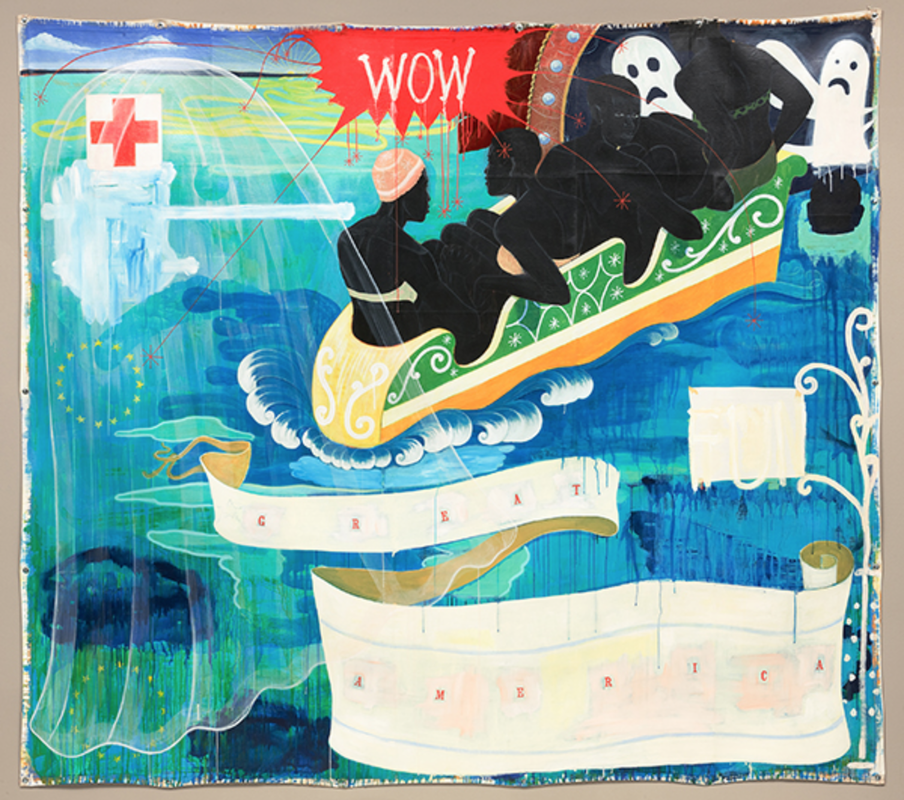More about Great America

Contributor
“We’re dealing with fragments, we’re dealing with parts of things, we’re not even dealing with a complete narrative,” Kerry James Marshall has said about the history of the Atlantic slave trade, the topic he is grappling with in Great America.
Marshall is a contemporary history painter, working in the same tradition as artists like Francisco Goya and Eugène Delacrox in his monumental canvases depicting scenes of Black life, both past and present, in the United States. But how do you represent the history of people who, as Marshall himself puts it, have been “severed from the culture, and history, and past they knew”? That history is largely lost, written over by the narratives of the Europeans who enslaved them and had something to gain by erasing their history and denying their humanity. “We’re dealing with recollections...bits of information that are themselves always being modified as more information becomes available to us, so that a collage sort of strategy, where you have pieces and fragments cobbled together, you might say—that seemed to be the most appropriate strategy to use to make this picture.”
Marshall also seems to be acknowledging in this painting that this history isn’t over, but continues to live on and resurface in the present; the two couples crammed into the boat together are at once modern Americans, about to enter the dark tunnel of a water ride at an amusement park, and ghosts from the past—the tight quarters of the boat and the man’s head bobbing in the waves are suggestive of the atrocities of the Atlantic slave trade, such as the Zong Massacre (famously portrayed by J.M.W Turner in his painting The Slave Ship). In 1781, the captain of the Zong, Luke Collingwood, overloaded his ship threw 132 enslaved people, who were sick and dying from disease and malnutrition, overboard. The drowning figure who is barely staying afloat in this picture could be an allusion to this horrific event.
In this painting, Marshall creates a space in which the past and the present exist simultaneously, as well as, to quote Marshall again, “excitement and terror...what I’m really trying to do is be able to capture both those feelings, both those senses of the experience, and hold them together at the same time.” Similarly, this painting simultaneously represents both the ideal of “Great America”—which is not only a real life theme park in California, but also a emblem of the United States’ rose-tinted idea of itself a place of freedom, equality, and opportunity for all—and the atrocious history of enslavement which contradicts that ideal, and yet without which the United States would not have been able to become the wealthy nation it is today.
The cartoon-y ghosts might speak to the fundamental unknowability of history—especially the history of slavery, from which Black voices are largely absent. We often feel as though we can revive the ghosts of the past by studying the lives of people in history, but in doing so, we turn them into something closer to a cartoon than a real person; a simplified outline of who they were, rife with projections of our present moment onto the past. Marshall may be making a similar statement about how we project ourselves onto history with the format of this painting; its canvas is stretched directly onto the wall rather than a frame, suggesting a projector screen of sorts. The ghosts at the entrance of the dark tunnel (who, not coincidentally, resemble members of the Ku Klux Klan), seem to be ushering the boatful of people toward the tunnel, which functions both as a literalization of the term “Middle Passage” and as a narrowing force that is about to be placed on these people’s lives. Another, larger ghost, semi-transparent, is laid between us and the scene like a veil, perhaps speaking to the ways in which the “cartooning” effects of looking upon the past from our vantage point in the present stands in the way of us ever knowing the real history of these people.
The “somehow compromised and always traumatic” past of Black people in the United States isn’t a theme that Marshall usually explores in his art, or at least not so directly. As evidenced by works like Untitled (Studio) and De Style, his usual goal is to normalize the presence of Black subjects in art, sometimes by painting Black people directly into works of the Western canon, and sometimes by depicting scenes of the everyday lives of Black Americans. He paints figures which appear both beautiful and, as he puts it, “self-satisfied,” in the same way that white people have been painting themselves for hundreds of years. But in Great America, he diverges from this project somewhat, facing the history of slavery as head-on as one possibly can given the fragmentary nature of the historical record. “You can’t have such a monumental event hovering in the back of your mind and not deal with it in some way, either directly or indirectly,” Marshall has said about his intentions in painting Great America. “But at some point, you have to figure out a way to come to terms with the magnitude of that moment. And for me, it was almost like having to come to terms with the magnitude of that moment before I could really go on myself.” As this painting shows, that “moment” isn’t something that exists safely in the far-distant past; its effects continue to reverberate in the present, and the history shown in Great America continues to unfold to this day.
Sources
- Bernard, Ian. “The Zong Massacre (1781).” Blackpast. October 11, 2011. https://www.blackpast.org/global-african-history/zong-massacre-1781/.
- Crow, Kelly. “Vivid Visions of Epic Injustices.” The Wall Street Journal. August 2, 2013. wsj.com/articles/SB10001424127887324809004578638223970147546.
- Museum of Contemporary Art Chicago. “Kerry James Marshall: Mastry.” May 2, 2016. YouTube video, 7:34. https://www.youtube.com/watch?v=K2bmHE7MRQU.
- National Gallery of Art. “Kerry James Marshall | nga.” January 16, 2014. Video, 7:19. https://www.nga.gov/audio-video/video/kjm-nga.html.
- Perrée, Rob. “Kerry James Marshall Great America.” Art and Literature (blog). Accessed March 22, 2021. http://robperree.com/news/831/kerry-james-marshall-great-america.
- Rowell, Charles H. and Kerry James Marshall. “An Interview with Kerry James Marshall.” Callaloo 21, no. 1 (1998): 263-272.
Featured Content
Here is what Wikipedia says about Great America (painting)
Great America is a 1994 acrylic-and-collage-on-canvas painting by American contemporary artist and professor Kerry James Marshall.
Check out the full Wikipedia article about Great America (painting)












